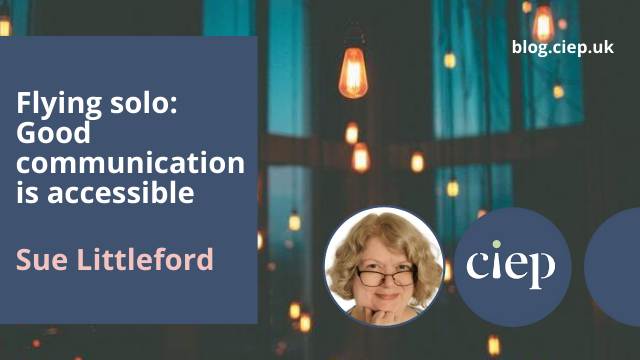In this latest Flying solo post, Sue Littleford looks at the importance of accessibility in business communication.
 Accessibility shouldn’t be an afterthought. You shouldn’t make a thing and then think, ooh, I guess I should make it accessible. Instead, build accessibility into the thing from the start.
Accessibility shouldn’t be an afterthought. You shouldn’t make a thing and then think, ooh, I guess I should make it accessible. Instead, build accessibility into the thing from the start.
We wordsmiths know that accessibility for every reader begins with the right words.
From an editorial point of view, that means clarity in your communication with clients and authors.
From a business point of view, that means clarity in your website text, your emails, your contracts and definitely in your small print. This is the angle I’ll be looking at.
Even if you have a law degree, your client may not
Just as one of the things we can easily spot is when an author has tried to reach for the big words, words that they’re not completely in command of, so it is with writing your T&Cs and anything vaguely legal, whether that’s in emails, on your website or in your contract.
Absolutely, ensure the necessary points are covered. Writing your T&Cs in straightforward language helps you to be clear about what you offer, and what you require from a client. It then helps your client understand what it is they’re signing up to, which is one of the key ways you can prevent problems from appearing later on.
So many problems with clients stem from a lack of mutual understanding of what’s being bought and what’s being sold.
I really rate Karin Cather and Dick Margulis’s book The Paper It’s Written On: Defining Your Relationship with an Editing Client (ISBN 9781726073295), and I recommend it in the Going Solo guide.
At the time of writing, the Kindle edition is £5.98 and the paperback £9.81 through Amazon – a modest price for such an incredibly helpful guide through the complexities of contracts, and priceless if it means you sidestep problems with a client.
Although the book is written by Americans, it’s not the legal jurisdiction that’s important in this little book (70 pages) so much as the explanations of the breadth and nature of the kinds of things you want to nail down.
Contracts – honest ones – are clear and unambiguous, and they spell out the responsibilities of each party to the contract. A good contract is, in short, accessible intellectually to all involved. A good contract will also include remedies if either you or your client fails to keep up their end of the bargain, and this will be worth its weight in gold to the other.
No weasel words, no wrapping things up in cod legalese that will confuse and may well backfire.
Emails are contracts, too
You may prefer to rely on an exchange of emails rather than a formal contract. That’s fine – the emails become the contract. So it’s essential that your emails contain everything you need the client to know about your transaction, in unambiguous terms. Bear this in mind when negotiating a job.
My confirmation emails rehearse the terms of the job, the terms of payment and so on, so that what is agreed is all in one place. Complete. Accessible.
 Good accessible communication is honest
Good accessible communication is honest
Be straight with your clients, even outside of a contract. Don’t confuse your potential clients with undefined technical terms – and if you’re having to define a lot of technical terms, shouldn’t you be using clearer language in the first place?
Do NOT promise perfection. You can’t deliver it, what with so much of English being subjective. I bore people senseless on this point, I know – but it is so important. Promising editorial perfection is, frankly, mis-selling.
Any editorial discussion on social media will show you the range of possible solutions to a drafting problem. Some you’ll doubtless discount as wrong for the context, but you will also find a range of perfectly sensible solutions, not just one sensible solution.
A client told to expect perfection may have preferred one of the other solutions, and a difference of opinion on the use of the serial comma, ending a sentence with a preposition, or just how essential ‘whom’ is these days may mean your edits are found wanting, despite being just fine for many other clients.
So be honest about what you bring to the job, and be clear that you can’t promise perfection, as perfection is in the eye of the beholder.
Accessible marketing
How accessible is your website? I’m not talking just about tech things like colour contrast, and alt text and aids for assisted reading.
Do you keep your paragraph-length short for easy reading on all sorts of devices?
Are your terms and conditions for the website as crystal clear as your contract for services?
If you maintain an email list, are your subscribers offered a genuine choice as to whether to join it? Can they unsubscribe readily? Do you make it clear in every mailout how to do that?
Sweat the small stuff
I recently had an email from a fellow editor and noticed in their email signature that they were still linking to their directory entry through the old sfep.org.uk address. Their LinkedIn URL was still using http://.
Both those addresses still work just fine for now – until they don’t. Your email signature is a great opportunity to reinforce your brand and marketing: is it clear, up to date and accurate?
The ultimate small stuff is, of course, small print – content that punches above its weight. How accessible is the small print for your cookie widget on your website? Your privacy notice for GDPR compliance?
What about your profiles on places like LinkedIn or, indeed, the CIEP Directory of Services? Do you speak plainly of what you offer? Will your target client actually understand what they’ll get when they approach you?
Accessibility is good customer service
All this boils down to good customer service – as always, I’m going exhort you to put yourself in your client’s (or potential client’s) shoes and bring them along with you, cooperatively. Avoid the hard sell wrapped up in unclear, weaselly contract terms, opaque jargon (jargon editor to editor is sensible shorthand; jargon editor to novice author is not accessible) and sneaky email address capture for marketing.
A good client relationship will be built on openness, clarity and honesty – in brief, on accessibility.
Sue started writing her Flying solo column at the beginning of 2021. She’s covered checklists, customer service, using business records to make decisions, useful UK tax resources and lessening the impact of our business on the environment.
About Sue Littleford
 Sue Littleford is the author of the CIEP guide Going Solo, now in its second edition. She went solo with her own freelance copyediting business, Apt Words, in March 2007 and specialises in scholarly humanities and social sciences.
Sue Littleford is the author of the CIEP guide Going Solo, now in its second edition. She went solo with her own freelance copyediting business, Apt Words, in March 2007 and specialises in scholarly humanities and social sciences.
 About the CIEP
About the CIEP
The Chartered Institute of Editing and Proofreading (CIEP) is a non-profit body promoting excellence in English language editing. We set and demonstrate editorial standards, and we are a community, training hub and support network for editorial professionals – the people who work to make text accurate, clear and fit for purpose.
Find out more about:
Photo credits: lightbulbs by Dil; speech bubble by Volodymyr Hryshchenko, both on Unsplash.
Posted by Abi Saffrey, CIEP blog coordinator.
The views expressed here do not necessarily reflect those of the CIEP.
